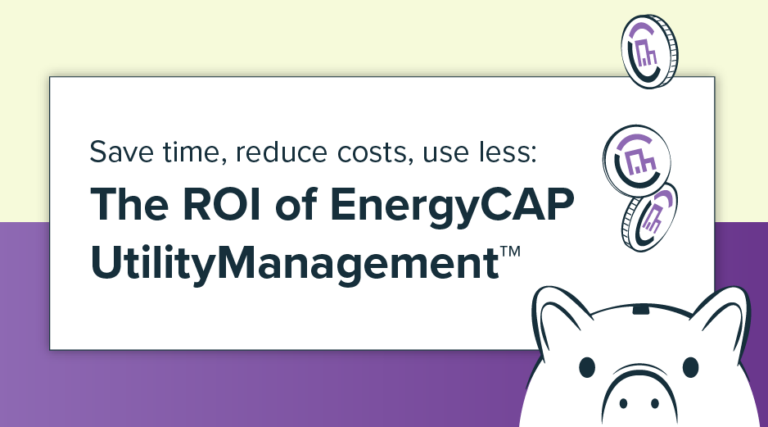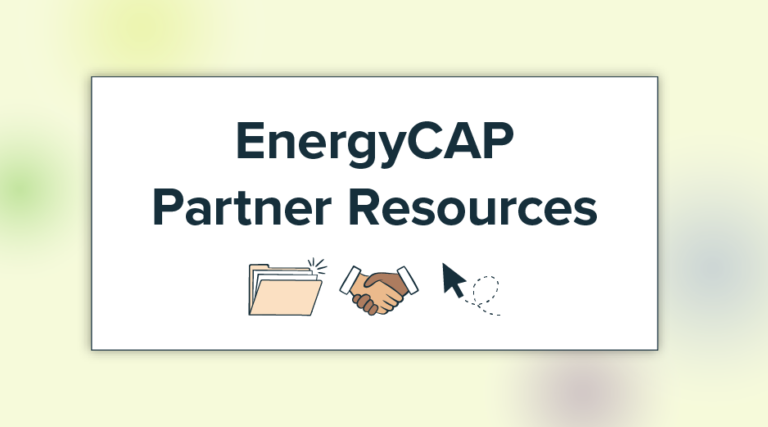Energy and Sustainability Compliance for Utilities
Introduction
Legislative expectations on utilities are growing year over year. As governments across the nation grapple with ballooning budgets and looming net zero goals, legislatures are turning to a trail blazed by states like Washington and New Jersey: first, measure the energy and water usage of large buildings to understand current consumption levels, then tailor conservation incentives to those findings. The anticipated outcome–an immediate reduction in annual energy consumption of 3.5% or more. Utilities are required to gather and submit this energy usage information on behalf of their commercial customers, putting them at the center of these regulations and requiring new internal programs to manage up to tens of thousands of data requests annually, depending on the population served.
In addition to assisting with the clean energy goals of their states, utilities also have their own. More than 80% of U.S. utilities have a carbon reduction target, most of those to become 100% carbon free. One of the keys to meeting these goals is partnering with ratepayers, something utilities can use a little help with, especially as a new generation of customers turns to them for more digital tools and proactive partnership in energy reduction guidance. The good news: with the right tools, utilities have an opportunity to turn this legislation into greater customer engagement and satisfaction, setting them up as trusted business, legislative, and community partners through the energy transition.
Types of sustainability legislation affecting utilities
Building Benchmarking
Buildings account for roughly 40% of the energy consumed in the United States. Recognizing the opportunity to reduce this number, as well as improve associated fiscal, health, and environmental outcomes, state legislatures are mandating building benchmarking as the first step to improved building energy performance.
What are building benchmarking laws?
Also known as clean building, energy benchmarking, or building transparency laws, building benchmarking is proliferating across the country as governing bodies look for a data-driven approach to meaningful energy conservation. In short, building benchmarking requires large building owners to report gas, electric, and sometimes water usage data to a common system—most often ENERGY STAR® Portfolio Manager®—on at least an annual basis so that each building’s energy performance can be tracked over time, as well as compared to similar buildings.
These laws typically have consistent core requirements: certain buildings must measure and report energy consumption data; utilities provide access to this whole-building data and assist building owners with reporting; and state and local governments publish the findings.
Other parts of the legislation vary greatly from place to place:
- Building tiers. Many states, though not all, are taking an approach where larger buildings, and/ or certain types of buildings, report earlier with smaller and other property types following later. These are generally broken down by tier – for example, nonresidential, government, and large footprint buildings may report first as tier 1, with multifamily, smaller footprint, and other business types in tier 2.
- The number of buildings required to report based on size and industry type. The square footage minimums and types of buildings required to report vary greatly from state to state. Some states, like Maryland, exempt manufacturing operations from benchmarking requirements, opting instead for low carbon energy source incentives. Other states expect manufacturers to report and reduce energy usage along with everyone else.
- Consequences for noncompliance. New Jersey does not punish building owners for refusing to report, instead they reward those who do with incentive programs. Other states employ steep financial penalties. Washington fines building owners up to $1 USD/per ft²/per day until data is submitted.
- Notice periods. Early adoption states gave building owners and utilities significant notice of reporting deadlines. As low carbon and energy reduction goals have loomed closer, however, these notice periods are shrinking.
Where is this legislation in place?
20% of the country has statewide benchmarking legislation enacted, many of those laws arriving only in the past few years. Many cities and regions have independently enacted them as well. This number is expected to grow exponentially as the successes of existing programs are documented.
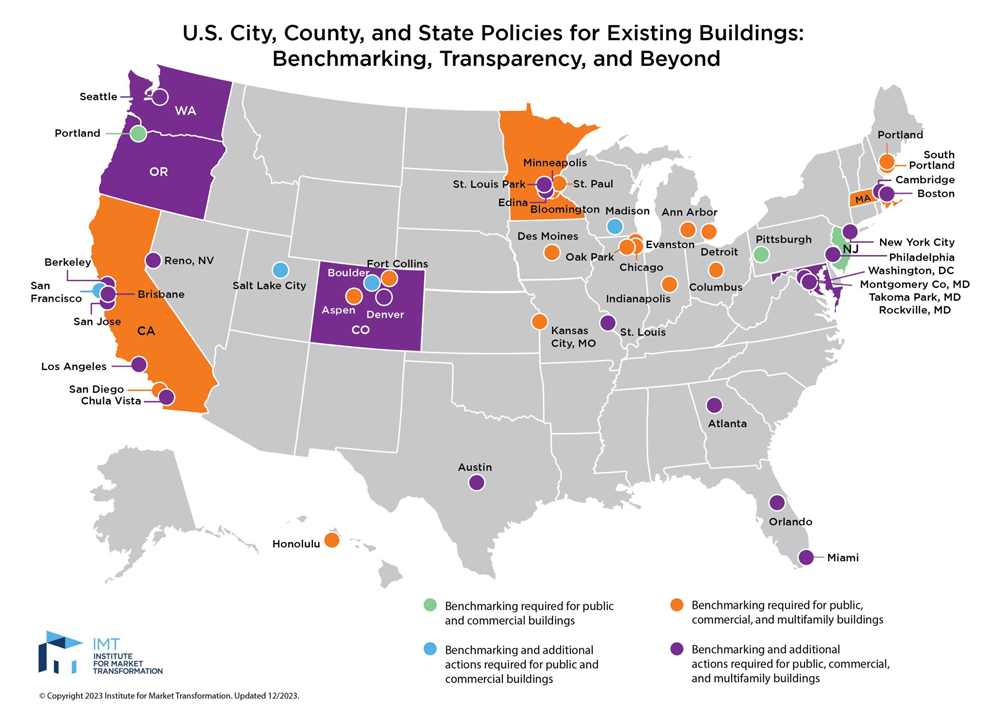
What exactly is expected of utilities?
Every building benchmarking law on the books requires direct action from utilities to help their commercial customers comply. This assistance comes through one of two routes:
- Utilities must aggregate and submit data on behalf of affected customers directly to the benchmarking platform being used in that state, most often ENERGY STAR Portfolio Manager.
- Maintain an easy-to-access portal through which all commercial customers can request aggregated data at any time. Utilities must then provide this data in a timely manner and formatted for immediate upload into the benchmarking platform. For ENERGY STAR, this will be an Excel spreadsheet.
Some states require that both of these options are available.
Data aggregation and tenant releases
States have been careful to balance the building owner’s need to access and report on consumption data for their properties with the privacy rights of tenants within those properties who may be the ones consuming the utilities and paying the bills. Therefore, in buildings with multiple tenants, utilities are required in many states to aggregate, or total up and anonymize, usage data before providing it to building owners. Sometimes, when there are only a few tenants in a building and aggregating the data cannot realistically anonymize the usage information, states go a step further and require written consent from tenants for their data to be used for benchmarking compliance purposes. Utilities must assist building owners with circulating, receiving, and tracking approvals via tenant release forms, and only provide data from those tenants who have consented. This process can become onerous, especially when it is manually completed, consuming a utilities’ time and resources.
Funding
States recognize the financial and administrative burden being placed on utilities to do the legwork of building benchmarking. The ways for utilities to recoup at least some of the cost of standing up their compliance programs vary from state to state. Some allow utilities to include building benchmarking compliance cost in the pursuit of a scheduled rate case, or to request a special, independent rate case. Other states set aside funding, generally per square foot of affected building space, to award utilities. However, even with financial backing to set up their programs, the time and resource investment of compliance is entirely on the shoulders of utilities.
What is ENERGY STAR Portfolio Manager?
Most states have turned to the EPA’s ENERGY STAR Portfolio Manager as their chosen benchmarking platform for the simple fact that it is already the premiere energy benchmarking tool nationwide—in use by one in four US commercial buildings today. Portfolio Manager is a free online tool to measure and track energy and water consumption through a standard set of data inputs. In addition to utilities, energy service companies, individual building owners, and regional efficiency programs can send building energy consumption data to Portfolio Manager receiving ENERGY STAR scores, weather normalized energy use intensity (EUI) benchmarks, and carbon emissions estimates in return. States and building owners can then use the information provided by ENERGY STAR to track building performance over time, compare the data to other buildings, and plan energy reduction roadmaps. ENERGY STAR has a plethora of resources for utilities including guidance on tenant releases, an introductory resource kit, and a live map of utility benchmarking partners.
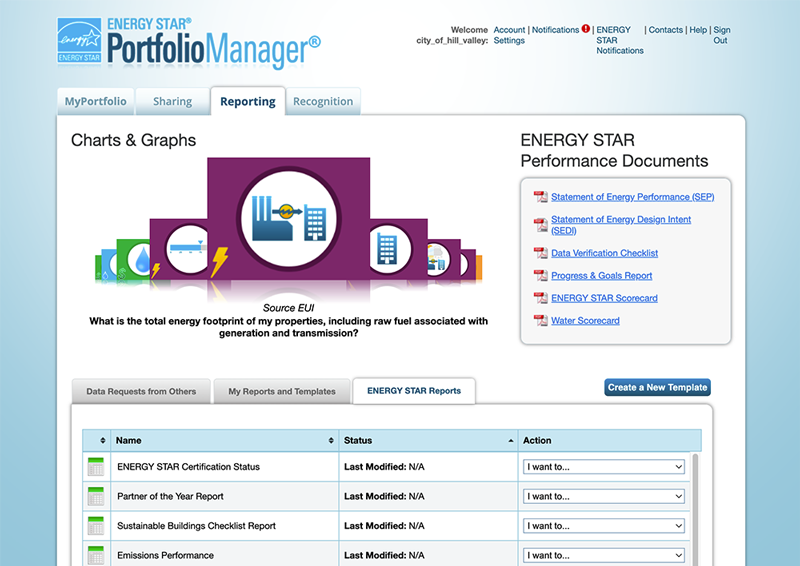
What are the key takeaways for utilities?
These laws come with a great deal of variation from state to state, and utilities must dedicate time and resources to intimately understanding legislation in their area, whether proposed or established. Utilities also need to be aware that, even if benchmarking legislation is not currently proposed in their city or state, these laws are proliferating very quicky and grace periods before mandated reporting are shrinking. The safe assumption is that all United States utilities will be subject to these requirements, and they should establish a benchmarking program in the coming months. Utilities that have begun offering benchmarking data submission to large and commercial customers, even in the absence of legislation, are finding that these programs build the trust, loyalty, and collaboration of large commodity users, buy them a seat at the table with utility commissions and legislatures when these laws are proposed, and prepare them for inevitable legal obligations in the future.
The safe assumption is that all United States utilities will be subject to these requirements, and they should establish a benchmarking program in the coming months.
Greenhouse Gas Reduction
About 40% of US electricity comes from low carbon sources today. Additionally, 33% of the country’s total annual energy consumption is natural gas. While achieving nationwide net-zero status by 2050 is technologically feasible, it requires ongoing and significant changes in investment, operations, and policy related to the energy sector. Since utilities are the central players in energy consumption, connecting energy production with the ratepayers who consume it, legislators and regulators have begun to take strong actions directly affecting utilities and their customers. While collectively known as greenhouse gas (GHG) reduction or net-zero goals, the legislation impacting utilities to achieve these ends has taken a number of forms.
What does “net-zero” mean?
Achieving zero emissions would mean no greenhouse gases of any kind (CO2, methane, nitrous oxide, etc.) are released into the atmosphere at all. More realistic is net-zero, where GHG emissions are taken as close to zero as possible and the remaining emissions are offset by credits, captured and sequestered, or repurposed by technology. As a country, the US has a goal of achieving net-zero status by 2050. Some areas, and many businesses and organizations, have more aggressive timeframes, like 2030.
What net zero legislation is affecting utilities?
The legislative landscape for utilities is changing constantly in this regard. Similar to building benchmarking legislation, consistent regulation is being developed to define changes utilities must make, but the specifics vary greatly from place to place. A few examples include:
- Mandated GHG reduction plans. Many states require utilities to develop their own emission reduction plans and submit them to their local utility regulators for approval. Going beyond distributing energy from low carbon sources, these plans often require utilities to alter their financial portfolios to invest in low carbon energy, develop and invest in negative emissions technologies, and purchase offsets. They may also require utilities to establish a sustainability working group, employ an energy manager, or benchmark and improve performance of their own buildings and facilities as well. Even once these plans are established, public utility commissions are following progress closely and considering penalties for utilities who fall behind. Ratepayers are calling for limits on the costs laid at their feet for compliance, wary of placing the financial responsibility for decades of carbon heavy infrastructure on current customers alone.
-
Natural gas legislation. Natural gas providers are coming under particularly intense environmental scrutiny, especially given concerns about the health and ecological impacts of fracking. Some states are formally investigating natural gas utilities and requiring compliance with gas-system transition plans, while others are considering banning natural gas appliances in new construction.
To complicate matters, the strategy gas distribution companies has long relied on to decrease emissions is being phased out. State utility commissions are finding that costs for long-term infrastructure improvement plans, which utilize rate increases to pay for replacement of leaking pipe and reduce latent emissions, are massively higher than initially estimated. Despite the increased budget generated from customer rate increases, utilities still consistently miss replacement cost-per-mile targets. In New York, for example, their replacement program puts a reimbursement burden of $60,000 on each natural gas customer. Legislatures have come to realize this method locks in decades of fossil fuel use, spending ratepayer money while doing little to address climate goals. While these plans were summarily pushed through in the past, new proposals are being paused or rejected outright. For their part, natural gas providers are confident they can leverage the unique advantages of pipeline infrastructure and gas technology to play a critical role in the energy transition, repurposing transmission networks for transportation of hydrogen or renewable natural gas from sustainable feedstock among other things.
-
Climate Risk and Financial Disclosures. The Securities and Exchange commission’s (SEC) recent pending rules that mandate climate related risk planning and disclosures from publicly traded companies specifically include investor-owned utilities. This means that affected utilities must develop and publish climate risk, risk management, governance, and financial disclosures. Infrastructure and financial consulting firms anticipate significant scrutiny of utilities’ disclosures, given that investors are keen to understand their contribution to climate shifts and review their proposals for carbon reduction.
In addition to climate disclosures, the question of utilities’ legal obligations to plan for climate change has become increasingly prominent. Some experts believe state tort and public utility laws put utilities at fault if they fail to plan for and address climate change, with legal advocates urging energy providers to reorient risk assessment and management strategies to address at least the currently known impacts of climate change. Additionally, as weather and precipitation patterns are altered, utilities will find themselves facing legal and financial consequences if their infrastructure and equipment do not adapt. Simply look to the battle between the state of Hawaii and the electric utility whose equipment malfunction, exacerbated by drought-stricken conditions, could find Hawaiian Electric Industries on the hook for more than $3.8B in damages and deaths.
What’s next for utilities
We’ve reviewed two main types of legislation affecting utilities: building benchmarking requirements and GHG reduction. Utilities may have some concerns about both types of laws, but they’re here to stay. The outcome of compliance is a brighter energy future where utilities continue to play a pivotal role; a win for everyone.
These laws also present an incredible opportunity for utilities to engage more with their customers, supply them with better tools, and successfully activate and improve energy use reduction plans. The key to this success is data. By understanding and sharing their data, utilities can not only launch effective compliance programs to address these new laws, but better understand their customers, increase retention rates, and turn compliance into a two-way street of improved customer communication and satisfaction. These laws will continue to propagate, and there are a number of steps utilities should be taking to maximize the benefits for themselves and customers while minimizing stress, confusion, and time investment. Utilities should look to:
- Gain a seat at the table where legislative discussions are taking place
- Maximize customer communication and give them the insights they want
- Combine communication with data insights for successful GHG reduction compliance
- Lean on trusted experts for help
- Implement an off-the-shelf compliance tool with the power of a customer portal
- Define your scope 1, 2, and 3 emissions footprint
Gaining a seat at the table
Customer satisfaction with their utilities is decreasing, and regulators have substantial concerns that utilities aren’t doing enough to support the clean energy transition. They’ve responded by enacting the types of legislation discussed in this document, and the path forward for utilities is clear: leading the way in data access to customers, proactively providing compliance tools, and transitioning from passive to proactive partners will gain utilities a stronger, louder, more credible voice with legislatures, regulators, and customers. This will put them at the center of shaping the types and timelines of legislation enacted in the future.
Give customers the insights they want
Building benchmarking laws require customer engagement, and with ratepayers already clamoring for more insights from energy providers via the technology channels they want to use, utilities have an opportunity to satisfy customer needs while meeting regulations. Since utilities must create a portal for their commercial customersto access usage data, utilities could consider expanding this portal to include both commercial and residential customers. This would provide all customers with access to actionable energy usage data, along with another tool to communicate with their utility.
Turn that communication into engagement to achieve GHG reductions
General energy conservation advice on a static webpage is unlikely to meaningfully change customers’ energy consumption habits. Customers want utilities to provide them with customized insights, reports and visualizations, and unique plans of action that will make a difference in their monthly bills. Similarly, public utility commissions aren’t accepting GHG reduction strategies that offer nonspecific platitudes about getting customers to use less energy, especially when fewer than 20% of customers are even aware of utilities’ GHG goals. If a utility gives customers access to meaningful data as advised above, the natural next step is maximizing both that data and the data portal to communicate with customers and propose specific changes they can actually follow through on—setting the stage for meaningful customer participation in GHG reduction goals.
Where can utilities find help?
Though benchmarking may be new to utilities, it’s not new to EnergyCAP and it certainly isn’t new to ENERGY STAR. For over four decades, EnergyCAP has been helping thousands of utilities’ large customers–hotels, campuses, manufacturing facilities, and others, manage their resource consumption, reduce their carbon footprint, and save costs. We live and breathe utility bill data, and we’ve already helped utilities across the country successfully implement compliance programs to meet the exact laws explained here. We know a thing or two about benchmarking using ENERGY STAR and are proud to use the expertise we’ve gained as a five-time ENERGY STAR Partner of the Year for our automated the Portfolio Manager® submittal process. We’re here to serve as a resource for utilities, and you can call on us anytime to answer questions, share knowledge, and give customized advice.
For over four decades, EnergyCAP has been helping thousands of utilities’ large customers–hotels, campuses, manufacturing facilities, and others, manage their resource consumption, reduce their carbon footprint, and save costs.
ENERGY STAR recently celebrated its 30th anniversary. In that time the program has grown to encompass tens of thousands of organizations, utilities, and state and local governments who have partnered with the government to reduce greenhouse gas emissions. Through the Portfolio Manager system, property owners and building managers can receive their energy scores, set investment priorities, identify under-performing buildings, verify efficiency improvements, and go through the ENERGY STAR certification process. As the system of record for state benchmarking laws, ENERGY STAR provides a library of resources and help documents for building owners and utilities who are using their platform for the first time.
Simplify and automate with an all-in-one platform
Developing an in-house program that relies on manual processes through spreadsheets and emails for submitting building benchmarking data , is simply not an attractive option for many utilities. Utilities who have gone this route have struggled with the substantial time investment required of their employees, steep learning curve of integrating with new systems, and the long timeline to establish a solution with limited functionality. There is another way: implementing an off the shelf software that istailor made to meet the needs of, and execute, a building benchmarking compliance program, that also has the power to serve as a customer communication portal.
EnergyCAP Utility Company Platform™ (EUCP) is a tailor-made software for utilities to better serve their customers and meet the regulatory requirements of their regions. EUCP simplifies the compliance process, makes data more transparent, and offers a secure platform to communicate with customers and ENERGY STAR. EUCP automates each step of benchmarking compliance and provides data in a platform that allows customers to do their own data analysis–setting the stage for meaningful GHG reductions. EnergyCAP Utility Company Platform is:
- Completely Automated–the program can run without any manual intervention needed, or checkpoints can be added.
- Continuously upgraded and updated–purpose-built systems aren’t agile in the face of changing reporting requirements and EPA updates. EnergyCAP is constantly updating the functionality of EUCP without disrupting the customer experience.
- Off-the-shelf and ready to implement with our professional project management services
- Hosted in a secure, best in class environment designed to handle utility scale data.
- Already in use by utilities across the nation.
- Customer centered–the self-service platform puts utilities’ commercial customers in charge of the benchmarking process. EUCP can be expanded to an all-customer portal supplying the data customers crave and utilities need for their participation in GHG reduction goals with features like:
- Energy efficiency tracking
- Use/cost avoidance
- Interval data analysis
- GHG equivalence and reporting
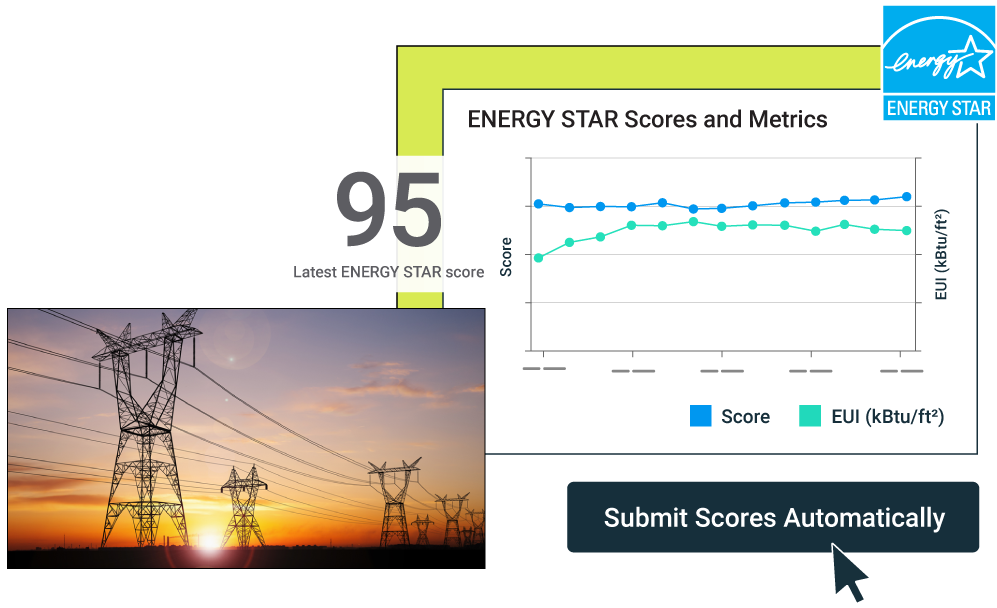
What are the most common challenges for utilities as compliance deadlines approach?
The most common challenges utilities face on the road to benchmarking are: navigating new systems, like ENERGY STAR™ for the very first time; trying to stand up an in-house program quickly; marrying a new benchmarking platform with existing analysis tools already being used by commercial customers; ensuring accurate data aggregation; and managing the tenant release process—which in itself can be an administrative nightmare.
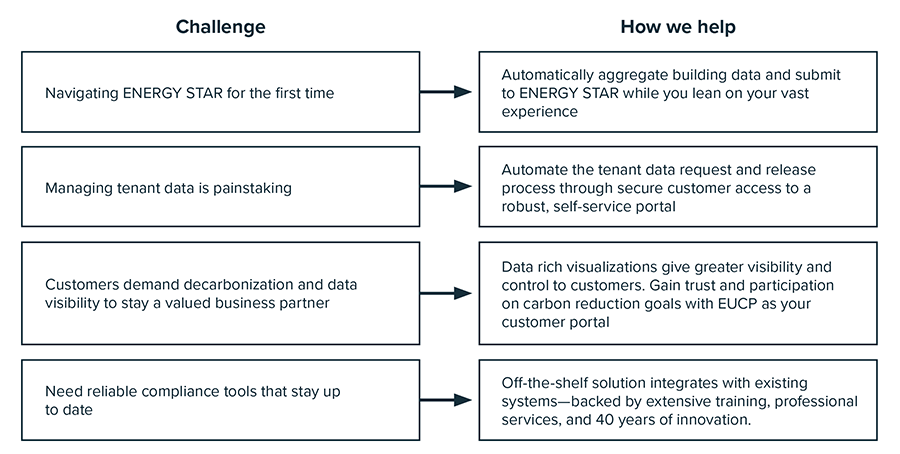
EnergyCAP Utility Company Platform™ is designed to help utilities with all of these challenges, and more. For an in-depth understanding of the platform, EnergyCAP has numerous resources available.
Know your scopes
In addition to helping their states and customers with decarbonization, utilities have their own GHG reduction and transparency goals to meet. The SEC’s recent climate proposed disclosure rules also have significant repercussions and reporting requirements for utilities, something that is top of mind for energy leaders who may unfamiliar with the ins and outs of carbon accounting. While this will bring challenges due to the utility industry’s complexity and massive footprint, it also brings opportunity. As utilities move toward investor-grade climate and emissions reporting, they have the chance to address their internal energy transition strategy and goals.
EnergyCAP CarbonHub™ offers a compelling solution to help utilities by simplifying their carbon accounting processes. The software takes an organization’s energy and commodity information and automatically converts into Scope 1, 2, and 3 greenhouse gas emissions for streamlined accounting.
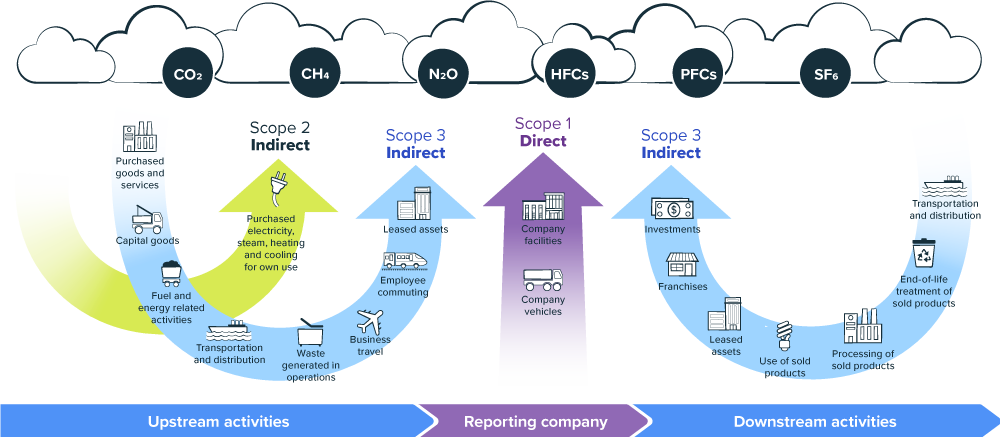
Public utility commissions are hungry for insight into the GHG progress utilities are making. In many cases, regional laws require utilities to report on the sustainability tools and methods they’ve adopted. In addition to being a tangible tool that utilities can highlight, EnergyCAP CarbonHub reports and dashboards allow utilities to communicate goals and progress to commissions and lawmakers—the dashboard embed feature can even provide stakeholders a website to check for live progress updates.
By leveraging the capabilities of EnergyCAP CarbonHub, utilities can position themselves as leaders in the clean energy transition, enhancing stakeholder trust, complying with disclosure and reporting laws, and achieving long-term success in a rapidly evolving market.
Conclusion
Utilities are under growing pressure to provide data—directly to their customers, on behalf of their customers, to lawmakers, and to regulators. At the center of many of these requirements are emerging building benchmarking and ongoing GHG reduction legislation. The bottom line is that in order to meet these legislative demands, utilities need the engagement of their customers. Simlarly, ratepayers need utilities – they want active partnership (not just general information), access to more data, and bespoke tools to help them manage their energy portfolios as lawmakers and oversight institutions are watching closely. Utilities can gain the trust of their stakeholders and a seat at the table where future legislative decisions are made by offering effective benchmarking compliance and tangible, actionable data management tools to their customers.
If utilities don’t wish to wade into the arduous process of establishing a from-scratch program to offer these solutions, or if they want to lean on the expertise of industry leaders, EnergyCAP has been serving utilities for years with tailor-made solutions and guidance. Utility Company Platform™ is built to satisfy the needs of building owners, customers, and regulators alike, integrate with external systems, and is designed to minimize the resources, personnel, and costs utilities must invest to launch a benchmarking compliance program. EnergyCAP Utility Company Platform is already in use by utility vendors across the country, whose staff benefit from the ongoing assistance, professional services, and training we can provide to them, end users, and even regulators. EnergyCAP has already built a self-service solution from the ground so that utilities and their teams can focus on what they do best.
Visit www.EnergyCAP.com to learn more.
 Best-in-class portfolio-level energy and utility bill data management and reporting.
Best-in-class portfolio-level energy and utility bill data management and reporting.
 Real-time energy and sustainability analytics for high-performance, net-zero buildings.
Real-time energy and sustainability analytics for high-performance, net-zero buildings.
 A holistic view of financial-grade scope 1, 2, and 3 carbon emissions data across your entire business.
A holistic view of financial-grade scope 1, 2, and 3 carbon emissions data across your entire business.
 Energy and sustainability benchmarking compliance software designed for utilities.
Energy and sustainability benchmarking compliance software designed for utilities.





